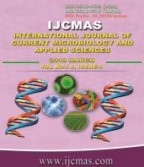


 National Academy of Agricultural Sciences (NAAS)
National Academy of Agricultural Sciences (NAAS)

|
PRINT ISSN : 2319-7692
Online ISSN : 2319-7706 Issues : 12 per year Publisher : Excellent Publishers Email : editorijcmas@gmail.com / submit@ijcmas.com Editor-in-chief: Dr.M.Prakash Index Copernicus ICV 2018: 95.39 NAAS RATING 2020: 5.38 |
In India rice-wheat cropping has been adopted widely which leads to deterioration of soil fertility and decrease in water use efficiency. In addition to these change in climate, vagaries of monsoon also leads to decrease in yields of the crop. Conservation agricultural (CA) based management practices together with nutrient management have demonstrated to produce more with less by these way it also conserve and sustain natural resources. In north eastern India maize crop is grown alternative to rice based cropping system due to variability in climatic condition and degradation of resources. Therefore, we attempted to evaluate the rice maize cropping system under conservation agriculture. The experiment was established in the year 2010 in Kharif season at Trihut College of Agriculture, Dholi, India. It was laid out in split plot design. The treatments in the main plot were the combination of tillage viz., zero tillage (ZT), conventional tillage (CT) and permanent bed (PB) whereas, in subplot were the combination of nutrient management viz., RDF, SSNM and FFP. However, rice is planted in kharif season and maize is sown in rabi season. After 7 years the results revealed that there was no significant difference in tillage treatment in rice grain yield but ZT (51.5 q/ha) showed higher yields with compare to CT (51.0 q/ha) and PB (49.3 q/ha). In Nutrient management FFP (52.7 q/ha) showed significantly higher grain yield. However, rice stalk yield and Net returns was significantly superior in ZT and FFP treatments. In maize, permanent bed and SSNM treatments showed significantly superior grain yield (92.9 q/ha), stover yield (108.8 q/ha), net returns (Rs. 83457.9) and B: C ratio (2.00). The maize equivalent yield (MEY) was significantly higher in permanent bed (155.5 q/ha). Whereas, in nutrient management RDF (151.3 q/ha) and SSNM (151.3 q/ha) showed similar results over FFP (149.8 q/ha).
 |
 |
 |
 |
 |